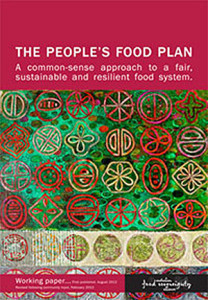By Steven Saint Thomas
Where is your next meal coming from? If you’re like most middle-class Americans, you don’t give it much thought. You’ll pick up food at the nearby grocery store, or pop into a restaurant or fast-food drive-through to get a meal someone else prepares for you.
As long as the grocery stores and restaurants stay in business, you are what they call “food secure.” If you ever stumble upon a discussion of “food security,” it usually revolves around poor people who have challenges accessing the current food system.
These people often live in so-called food deserts, where the closest place to get a meal is a convenience store or vending machine. Or maybe they just don’t have any money – access to food is not an inalienable right under the U.S. Constitution.
Now, suppose that our current food system collapses or is disrupted for a while. Maybe a drought in California wipes out half this year’s harvest and prices skyrocket. Maybe a Middle East conflict knocks out a major pipeline and gas prices jump, making it impossible for truckers to drive long distances with your food.
What if your nearby grocery chain is acquired and the new corporate owner decides to shut down the stores in your state because they are lower-performing or less-profitable?
Any of these possible scenarios would bring food security jumping like a jaguar over those poor people to beat down your middle-class door.
In 2010, the Australian government developed a national food policy. While recognizing the challenges of climate change and population growth, Aussie leaders declared the country “food secure.” After all, Australians produce three times the food they consume every year.
The government is taking that for granted and focusing on the business potential in positioning Australia as the bread basket for a food-insecure China.
Faith and investment in the status quo – a globalized food system owned and controlled by Big Ag, Big Oil and Big Box – is the de facto food-security policy of the U.S. as well. The Farm Bill – the closest thing Americans have to a national food policy – assumes if we give the Biggies what they want, we’ll all eat.
Permaculturists and others in Australia don’t share this faith. For two years, they criss-crossed their continent to develop a “People’s Food Plan” – a blueprint to help people feed themselves rather than rely on the Biggies.
The Australian government doesn’t pay much attention to the People’s Food Plan, but that’s OK. The whole point is regional self-reliance, the foundation of permaculture.
Does your state or county have a Food Future Plan? Has your region done a food assessment? What does your food system look like?
Colorado does not have a Food Future plan and the state’s sustainability coalition website doesn’t even mention food. Meanwhile, 5 million Coloradans import 95 percent of the food they eat. They are almost completely dependent on the global food system to survive.
Trendy civic leaders and politicians adore farmers markets and large grocery chains boast “local food,” but there is relatively little cultivation in Colorado and no push to encourage young entrepreneurs to go into farming.
Local-food stakeholders in my region need to draft a Food Future plan. The process began in earnest in 2010, but stalled. If we can complete the plan, at least we’ll have a blueprint to face the future. We might even know where our next meal will come from.





